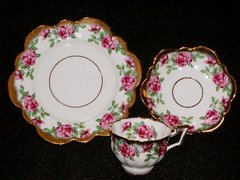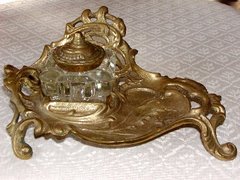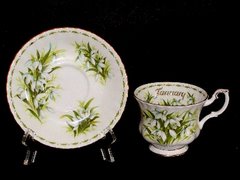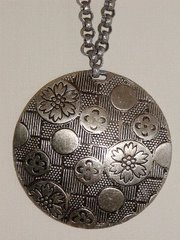
Completely contrary to the sound of its name, Depression Glass is quite beautiful and the colors you can find it in are almost endless. The name simply stems from the time period during which it was manufactured – from the early 1920s until the end of World War II, which spans the Depression Era and then some.
The majority of Depression Glass you see most often will probably be in the more common colors made: pink, amber, green, yellow, clear, and blue. Almost every other color imaginable was used also, but these were not as popular. Therefore it stands to reason that these colors with lower production numbers, like lavender and orange, command much higher prices today than the more popular shades. And because yellow and amber were far more popular in their day than pink, green, and blue, they are usually the most reasonably priced pieces found today.
Much like Nippon in its day, Depression Glass was not a high-priced commodity and could easily be found for under $1.00 a piece; in fact, some pieces sold for as little as 14 cents. It was not uncommon to find whole barrels and pieces sold by the dozen for just a few dollars, and it’s mind-blowing to think that some of these same pieces today can individually bring hundreds or even thousands of dollars. Oh, to stumble upon an attic or basement containing an unopened barrel of Depression ware!
There are two distinct categories of Depression Glass: Elegant and Depression. And within those categories are quite a number of different patterns, so it’s not unusual to find collections focused on particular patterns, colors, or styles of glass. The difference between Elegant and Depression is the care with which it was finished: Elegant glass required an extra step in manufacture, where a person would actually finish each piece by hand to remove mold marks, to acid-etch or cut patterns into the glass, or to grind the bottoms of objects the bottoms to make them perfectly even. While Depression Glass was not considered to be a high quality glass, their patterns made them very attractive and appealing.
Between 1923 and 1939, there were seven major producers of Depression Glass including: Indiana Glass Company; Hocking Glass Company, Federal Glass Company, U.S. Glass Company, Jeannette Glass Company, MacBeth-Evans Glass Company and Hazel-Atlas Glass Company. According to an excellent, highly-informative article by Joyce Krupey, 92 patterns are attributed to these seven producers. If you want to find out about the different patterns made, which companies made them, the years they were manufactured, and lots of other information about specific patterns, I highly recommend reading Krupey’s article.
The National Depression Glass Association is a very active organization with a comprehensive website covering just about every aspect of Depression Glass, collecting, glass clubs, and much more. It has several other wonderful articles about different aspects of Depression Glass, including milk glass, crystal Depression Glass, and an entire article about the well-known Iris & Herringbone pattern. It’s a great start to understanding this highly collectible field.
The majority of Depression Glass you see most often will probably be in the more common colors made: pink, amber, green, yellow, clear, and blue. Almost every other color imaginable was used also, but these were not as popular. Therefore it stands to reason that these colors with lower production numbers, like lavender and orange, command much higher prices today than the more popular shades. And because yellow and amber were far more popular in their day than pink, green, and blue, they are usually the most reasonably priced pieces found today.
Much like Nippon in its day, Depression Glass was not a high-priced commodity and could easily be found for under $1.00 a piece; in fact, some pieces sold for as little as 14 cents. It was not uncommon to find whole barrels and pieces sold by the dozen for just a few dollars, and it’s mind-blowing to think that some of these same pieces today can individually bring hundreds or even thousands of dollars. Oh, to stumble upon an attic or basement containing an unopened barrel of Depression ware!
There are two distinct categories of Depression Glass: Elegant and Depression. And within those categories are quite a number of different patterns, so it’s not unusual to find collections focused on particular patterns, colors, or styles of glass. The difference between Elegant and Depression is the care with which it was finished: Elegant glass required an extra step in manufacture, where a person would actually finish each piece by hand to remove mold marks, to acid-etch or cut patterns into the glass, or to grind the bottoms of objects the bottoms to make them perfectly even. While Depression Glass was not considered to be a high quality glass, their patterns made them very attractive and appealing.
Between 1923 and 1939, there were seven major producers of Depression Glass including: Indiana Glass Company; Hocking Glass Company, Federal Glass Company, U.S. Glass Company, Jeannette Glass Company, MacBeth-Evans Glass Company and Hazel-Atlas Glass Company. According to an excellent, highly-informative article by Joyce Krupey, 92 patterns are attributed to these seven producers. If you want to find out about the different patterns made, which companies made them, the years they were manufactured, and lots of other information about specific patterns, I highly recommend reading Krupey’s article.
The National Depression Glass Association is a very active organization with a comprehensive website covering just about every aspect of Depression Glass, collecting, glass clubs, and much more. It has several other wonderful articles about different aspects of Depression Glass, including milk glass, crystal Depression Glass, and an entire article about the well-known Iris & Herringbone pattern. It’s a great start to understanding this highly collectible field.
Visit Collector's Cottage for a variety of patterned glass.




No comments:
Post a Comment